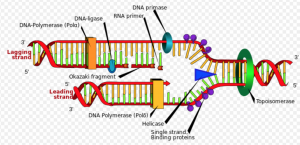
Dr. Idan Menashe from Ben-Gurion University: Now that we’ve found that the genomic length of autism-related genes is unusually long in relation to other genes manifested in the brain, we estimate that within 5 years, it will be possible to test for autism prior to pregnancy.
Gadi Golan and Israel Hayom Staff
Researchers at Ben-Gurion University in the Negev have made a significant breakthrough in a unique study to better understand autism, discovering a particular evolutionary signature in autism genes. The breakthrough brings doctors one step closer to understanding the genetic mechanism for the disorder, and being able to diagnose it prior to birth.

DNA – Animation: brian0918,Wikipedia
Dr. Idan Menashe and his colleagues, Erez Tsur and Prof. Michael Friger, studied over 650 genetic variations out of the 1,000 genes linked to autism, and found characteristics that differentiate them from other genes in the human genome.
“If we find the remaining genes out of the thousand, we will not only be able to understand autism better, but also be able to conduct a genetic test before pregnancy even, and perhaps, in the future, also find a cure to help fix the genetic distortions to prevent autism,” said Menashe.
“We can certainly estimate that within five years it will be possible to conduct this type of genetic test,” he said.
The unique characteristics of genes associated with autism spectrum disorder, among others, are unusual genomic length, longer than other genes manifested in the brain; and a genetic similarity to diseases such as Alzheimer’s disease and schizophrenia. Additionally, researchers found that ASD-related genes carry a signature typical of the genetic process known as negative evolutionary selection. This process is responsible for purging deleterious impacts on the genome, through a gradual process that spans generations.
Menashe and his colleagues also searched for signs of positive selection in these genes. This mechanism, according to Menashe, is responsible for increasing a mutation’s frequency in a certain genome until it is fixed, and can explain the existence of autism in humans. However, no signs of positive selection were detected in these genes. Regardless, the researchers suggest that the mutations linked to autism are a constant component of the human genome, because they lead to the appearance of the disorder only when combined with other genetic or environmental factors.
Finally, the researchers showed that the evolutionary signature associated with autism genes can be used to discover other genes with similar genomic characteristics, which could possibly also be linked to autism.
“These findings expand our understanding in relation to the genetic mechanisms involved in autism, and provide new tools for the discovery of additional genes linked to the disorder,” Menashe said.
“We believe that today, some 1,000 genes cause autism. And we are aware of 650 of them. The traits we found only characterize autism. We learned that they are relatively very long in comparison to any other gene, out of the 20,000 genes comprising the human genome,” he said.
View original Israel Hayom publication at:
http://www.israelhayom.com/site/newsletter_article.php?id=36785







 Israeli New Shekel Exchange Rate
Israeli New Shekel Exchange Rate